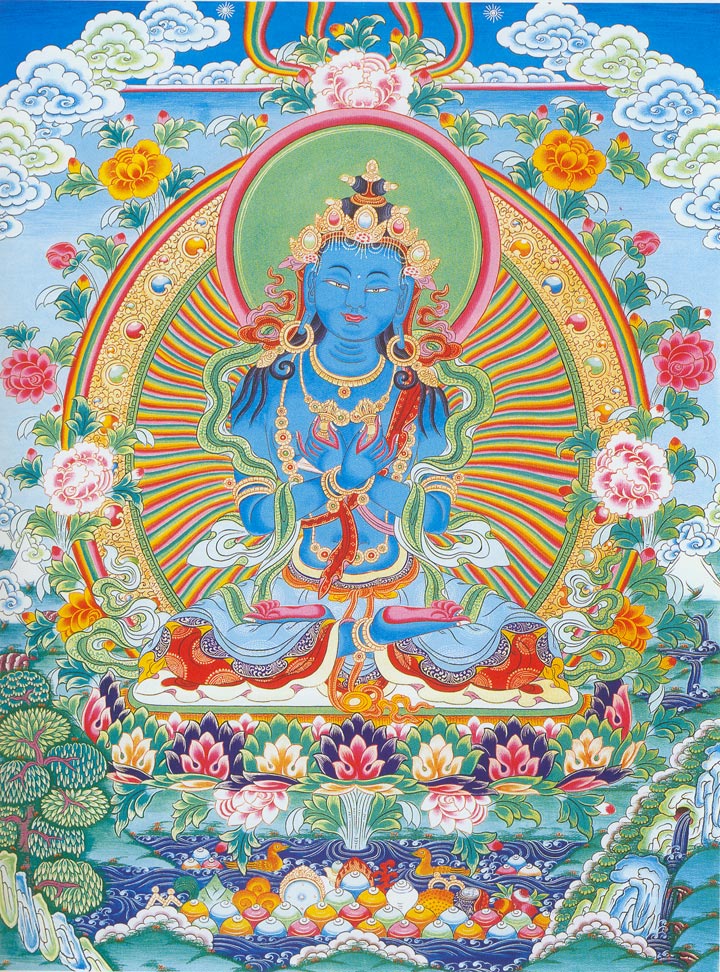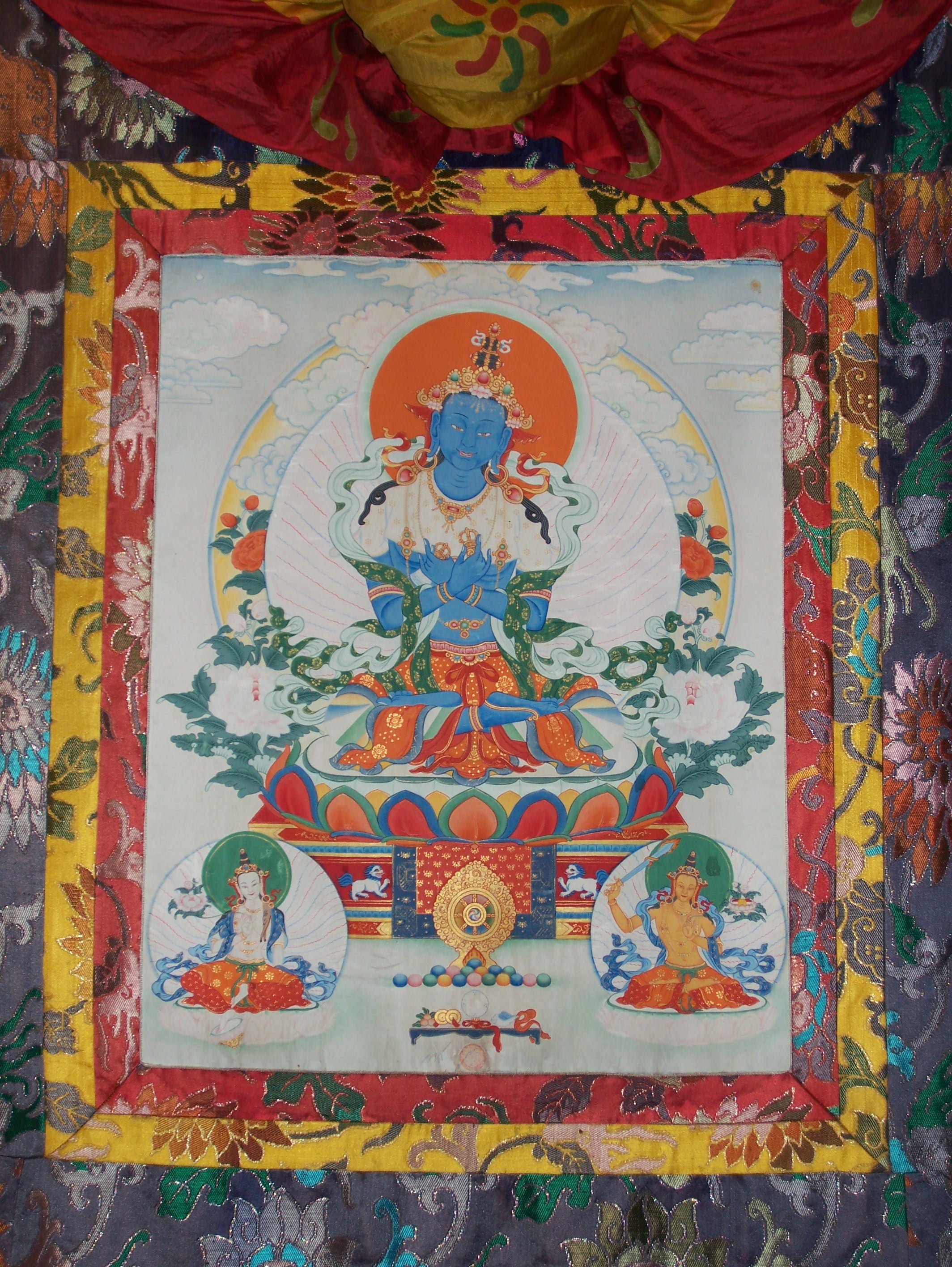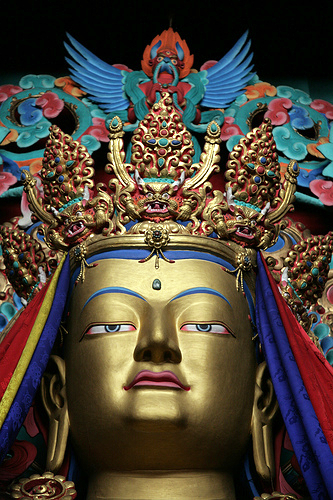|
Adi-Buddha
The Ādi-Buddha (, Ch: 本佛, Jp: honbutsu, First Buddha, Original Buddha, or Primordial Buddha) is a Mahayana Buddhist concept referring to the most fundamental, supreme, or ancient Buddha in the cosmos. Another common term for this figure is Dharmakāya Buddha. The term emerges in Tantras (Buddhism), tantric Buddhist literature, most prominently in the Kalachakra. "Ādi" means "first", such that the Ādibuddha was the first to attain Buddhahood. "Ādi" can also mean "primordial", not referring to a person but to an innate wisdom that is present in all sentient beings. In East Asian Buddhism, the term 本佛 (běn fó, original Buddha, root Buddha) also appears in the works of Tiantai and Tendai school, referring to the original Buddha of the ''Lotus Sutra'' which was also later identified with the cosmic Buddha Vairocana, Mahavairocana. It and similar terms were also used in the traditions of Chinese Esoteric Buddhism and Shingon Buddhism, Shingon to refer to the cosmic Budd ... [...More Info...] [...Related Items...] OR: [Wikipedia] [Google] [Baidu] |
Buddhahood
In Buddhism, Buddha (, which in classic Indo-Aryan languages, Indic languages means "awakened one") is a title for those who are Enlightenment in Buddhism, spiritually awake or enlightened, and have thus attained the Buddhist paths to liberation, supreme goal of Buddhism, variously described as Enlightenment in Buddhism, awakening or enlightenment (''bodhi''), ''Nirvana (Buddhism), Nirvāṇa'' ("blowing out"), and Moksha, liberation (''vimokṣa''). A Buddha is also someone who fully understands the ''Dharma, Dhārma'', the true nature of all things or Phenomenon, phenomena (''Abhidharma, dhārmata''), the Two truths doctrine, ultimate truth. Buddhahood (Sanskrit: ''buddhatva''; or ; zh, c=成佛) is the condition and state of being a Buddha. This highest spiritual state of being is also termed ''sammā-sambodhi'' (Sanskrit: ''samyaksaṃbodhi''; "full, complete awakening") and is interpreted in many different ways across schools of Buddhism. The title of "Buddha" is most c ... [...More Info...] [...Related Items...] OR: [Wikipedia] [Google] [Baidu] |
Trikaya
The Trikāya (, lit. "three bodies"; , ) is a fundamental Buddhist doctrine that explains the multidimensional nature of Buddhahood. As such, the Trikāya is the basic theory of Mahayana Buddhist theology of Buddhahood. This concept posits that a Buddha has three distinct ''kayas'' or "bodies", aspects, or ways of being, each representing a different facet or embodiment of Buddhahood and ultimate reality. The three are the '' Dharmakāya'' (Sanskrit; Dharma body, the ultimate reality, the Buddha nature of all things), the ''Sambhogakāya'' (the body of self-enjoyment, a blissful divine body with infinite forms and powers) and the '' Nirmāṇakāya'' (manifestation body, the body which appears in the everyday world and presents the semblance of a human body). It is widely accepted in Buddhism that these three bodies are not separate realities, but functions, modes or "fluctuations" (Sanskrit: vṛṭṭis) of a single state of Buddhahood. The Trikāya doctrine explains how a Bu ... [...More Info...] [...Related Items...] OR: [Wikipedia] [Google] [Baidu] |
Samantabhadra (Bodhisattva)
Samantabhadra () is a great bodhisattva in Buddhism associated with practice and meditation. Together with Shakyamuni Buddha and the bodhisattva Mañjuśrī, he forms the Shakyamuni Triad in Mahayana Buddhism. He is the patron of the '' Lotus Sutra'' and, according to the '' Avatamsaka Sutra'', made the ten great vows which are the basis of a bodhisattva. In Chinese Buddhism, Samantabhadra is known as Puxian and is associated with action, whereas Mañjuśrī is associated with '' prajñā'' (transcendent wisdom). In Japan, this bodhisattva is known as Fugen, and is often venerated in Tendai and Shingon Buddhism. In the Nyingma school of Tibetan Buddhism, Samantabhadra is also the name of the Adi-Buddha, often portrayed in indivisible union ('' yab-yum'') with his consort, Samantabhadrī. In wrathful form he is one of the Eight Herukas of the Nyingma Mahayoga and he is known as Vajramrtra, But this Samantabhadra buddha and Samantabhadra bodhisattva are not the same. In M ... [...More Info...] [...Related Items...] OR: [Wikipedia] [Google] [Baidu] |
Vairocana
Vairocana (from Sanskrit: Vi+rocana, "from the sun" or "belonging to the sun", "Solar", or "Shining"), also known as Mahāvairocana (Great Vairocana), is a major Buddha from Mahayana and Vajrayana Buddhism. Vairocana is often interpreted, in texts like the '' Avatamsaka Sutra'', as the Dharmakāya of the historical Gautama Buddha. In East Asian Buddhism ( Chinese, Korean, Japanese and Vietnamese Buddhism), Vairocana is also seen as the dharmakāya (the supreme buddha-body, the body of ultimate reality), and the embodiment of the Buddhist concept of wisdom and purity. Mahāvairocana is often translated into East Asian languages as "Great Sun Buddha" ( Chinese: 大日如來, pinyin: ''Dàrì Rúlái'', Japanese: ''Dainichi Nyorai''). In the conception of the Five Jinas of Mahayana and Vajrayana Buddhism, Vairocana is at the centre and is often considered a Primordial Buddha. In East Asian esoteric Buddhism, Mahāvairocana is considered to be a Cosmic Buddha whose body is th ... [...More Info...] [...Related Items...] OR: [Wikipedia] [Google] [Baidu] |
Lotus Sutra
The ''Lotus Sūtra'' (Sanskrit: ''Saddharma Puṇḍarīka Sūtram'', ''Sūtra on the White Lotus of the True Dharma'', zh, p=Fǎhuá jīng, l=Dharma Flower Sutra) is one of the most influential and venerated Buddhist Mahāyāna sūtras. It is the main scripture on which the Tiantai along with its derivative schools, the Japanese Tendai and Nichiren, Korean Cheontae, and Vietnamese Thiên Thai schools of Buddhism were established. It is also influential for other East Asian Buddhist schools, such as Zen. According to the British Buddhologist Paul Williams, "For many Buddhists in East Asia since early times, the ''Lotus Sūtra'' contains the final teaching of Shakyamuni Buddha—complete and sufficient for salvation." The American Buddhologist Donald S. Lopez Jr. writes that the ''Lotus Sūtra'' "is arguably the most famous of all Buddhist texts," presenting "a radical re-vision of both the Buddhist path and of the person of the Buddha." Two central teachings ... [...More Info...] [...Related Items...] OR: [Wikipedia] [Google] [Baidu] |
Dharmakāya
The ''dharmakāya'' (, "truth body" or "reality body", zh, t=法身, p=fǎshēn, ) is one of the three bodies (''trikāya'') of a Buddha in Mahāyāna Buddhism. The ''dharmakāya'' constitutes the unmanifested, "inconceivable" (''acintya'') aspect of a Buddha out of which Buddhas arise and to which they return after their dissolution. When a Buddha manifests out of the ''dharmakāya'' in a physical body of flesh and blood'','' which is perceptible to ordinary sentient beings, this is called a '' nirmāṇakāya'', "transformation body". The Dhammakāya tradition of Thailand and the '' Tathāgatagarbha sūtras'' of the ancient Indian tradition view the ''dharmakāya'' as the '' ātman'' (true self) of the Buddha present within all beings. Origins and development Pāli Canon In the Pāli Canon, Gautama Buddha tells Vasettha that the Tathāgata (the Buddha) is ''dhammakaya'', the "truth-body" or the "embodiment of truth", as well as ''dharmabhuta'', "truth-become", that ... [...More Info...] [...Related Items...] OR: [Wikipedia] [Google] [Baidu] |
Kalachakra
''Kālacakra'' () is a Polysemy, polysemic term in Vajrayana, Vajrayana Buddhism and Hinduism that means "wheel of time" or "time cycles". "''Kālacakra''" is also the name of a series of Buddhist texts and a major practice lineage in History of Buddhism in India, Indian Buddhism and Tibetan Buddhism. The tantra is considered to belong to the unexcelled yoga (''Anuttarayoga Tantra, anuttara-yoga'') class. Kālacakra also refers both to a patron Tantra, tantric deity or yidam in Vajrayana and to the philosophies and yogas of the Kālacakra tradition. The tradition's origins are in India and its most active later history and presence has been in Tibet. The tradition contains teachings on cosmology, theology, philosophy, sociology, soteriology, myth, prophecy, Ayurveda, medicine and yoga. It depicts a mythic reality whereby cosmic and socio-historical events correspond to processes in the bodies of individuals. These teachings are meant to lead to a transformation of one's body and ... [...More Info...] [...Related Items...] OR: [Wikipedia] [Google] [Baidu] |
Vajradhara
Vajradhara (; ; ; ; ; ) is the ultimate primordial Buddha, or Adi-Buddha, according to the Sakya, Gelug and Kagyu schools of Tibetan Buddhism. It is also a name of Indra, because "Vajra" means diamond, as well as the thunderbolt, or anything hard more generally. In the evolution of Indian Buddhism, Buddha Vajradhara gradually displaced Samantabhadra, who is the 'Primordial Buddha' in the Nyingma, or 'Ancient School.' However, the two are metaphysically equivalent. Achieving the 'state of Vajradhara' is synonymous with complete realisation. According to the Kagyu lineage, Buddhā Vajradhara is the primordial Buddha, the Dharmakaya Buddha. He is depicted as dark blue in color, expressing the quintessence of buddhahood itself and representing the essence of the historical Buddha's realization of enlightenment. As such, Buddha Vajradhara is thought to be the supreme essence of all (male) Buddhas; It is the Tantric form of Sakyamuni which is called Vajradhara. Tantras are tex ... [...More Info...] [...Related Items...] OR: [Wikipedia] [Google] [Baidu] |
Bön
Bon or Bön (), also known as Yungdrung Bon (, ), is the indigenous Tibetan religion which shares many similarities and influences with Tibetan Buddhism.Samuel 2012, pp. 220–221. It initially developed in the tenth and eleventh centuries but retains elements from earlier Tibetan religious traditions.Kvaerne 1996, pp. 9–10. Bon is a significant minority religion in Tibet, especially in the east, as well as in the surrounding Himalayan regions. The relationship between Bon and Tibetan Buddhism has been a subject of debate. According to the modern scholar Geoffrey Samuel, while Bon is "essentially a variant of Tibetan Buddhism" with many resemblances to Nyingma, it also preserves some genuinely ancient pre-Buddhist elements. David Snellgrove likewise sees Bon as a form of Buddhism, albeit a heterodox kind.Powers 2007, pp. 500–501 Similarly, John Powers writes that "historical evidence indicates that Bön only developed as a self-conscious religious system under the in ... [...More Info...] [...Related Items...] OR: [Wikipedia] [Google] [Baidu] |
Nyingma
Nyingma (, ), also referred to as ''Ngangyur'' (, ), is the oldest of the four major schools of Tibetan Buddhism. The Nyingma school was founded by PadmasambhavaClaude Arpi, ''A Glimpse of the History of Tibet'', Dharamsala: Tibet Museum, 2013. as the first translations of Buddhist scriptures from Pali and Sanskrit into Tibetic languages, Tibetan occurred in the eighth century. The establishment of Tibetan Buddhism and the Nyingma tradition is collectively ascribed to Khenpo Shantarakshita, Guru Padmasambhava, and King Trisong Detsen, known as ''Khen Lop Chos Sum'' (The Three: Khenpo, Lopon, Chosgyal). The Nyingma tradition traces its Dzogchen lineage from the Adi-Buddha, first Buddha Samantabhadra to Garab Dorje, and its other lineages from Indian mahasiddhas such as Sri Singha and Jnanasutra. Yeshe Tsogyal recorded the teachings. Other great masters from the founding period include Vimalamitra, Vairotsana, and Buddhaguhya. The Nyingma tradition was physically founded at Samye ... [...More Info...] [...Related Items...] OR: [Wikipedia] [Google] [Baidu] |
Shingon Buddhism
is one of the major schools of Buddhism in Japan and one of the few surviving Vajrayana lineages in East Asian Buddhism. It is a form of Japanese Esoteric Buddhism and is sometimes called "Tōmitsu" (東密 lit. "Esoteric uddhismof Tō-ji"). The word ''shingon'' is the Japanese reading of the Chinese word ('), which is the translation of the Sanskrit word mantra. The Zhēnyán lineage was founded in China (c. 7th–8th centuries) by Indian vajrācāryas (esoteric masters) like Śubhakarasiṃha, Vajrabodhi and Amoghavajra. These esoteric teachings would later flourish in Japan under the auspices of a Buddhist monk named Kūkai (, 774–835), who traveled to Tang China and received these esoteric transmissions from a Chinese master named Huiguo (746–805). Kūkai established his tradition at Mount Kōya (in Wakayama Prefecture), which remains the central pilgrimage center of Shingon Buddhism. The practice of the Shingon school stresses that one is able to atta ... [...More Info...] [...Related Items...] OR: [Wikipedia] [Google] [Baidu] |
Tibetan Buddhism
Tibetan Buddhism is a form of Buddhism practiced in Tibet, Bhutan and Mongolia. It also has a sizable number of adherents in the areas surrounding the Himalayas, including the Indian regions of Ladakh, Gorkhaland Territorial Administration, Darjeeling, Sikkim, and Arunachal Pradesh, as well as in Nepal. Smaller groups of practitioners can be found in Central Asia, some regions of China such as Northeast China, Xinjiang, Inner Mongolia and some regions of Russia, such as Tuva, Buryatia, and Kalmykia. Tibetan Buddhism evolved as a form of Mahayana, Mahāyāna Buddhism stemming from the latest stages of Indian Buddhism (which included many Vajrayana, Vajrayāna elements). It thus preserves many Indian Buddhist Tantra, tantric practices of the Gupta Empire, post-Gupta Medieval India, early medieval period (500–1200 CE), along with numerous native Tibetan developments. In the pre-modern era, Tibetan Buddhism spread outside of Tibet primarily due to the influence of the Mongol Emp ... [...More Info...] [...Related Items...] OR: [Wikipedia] [Google] [Baidu] |










